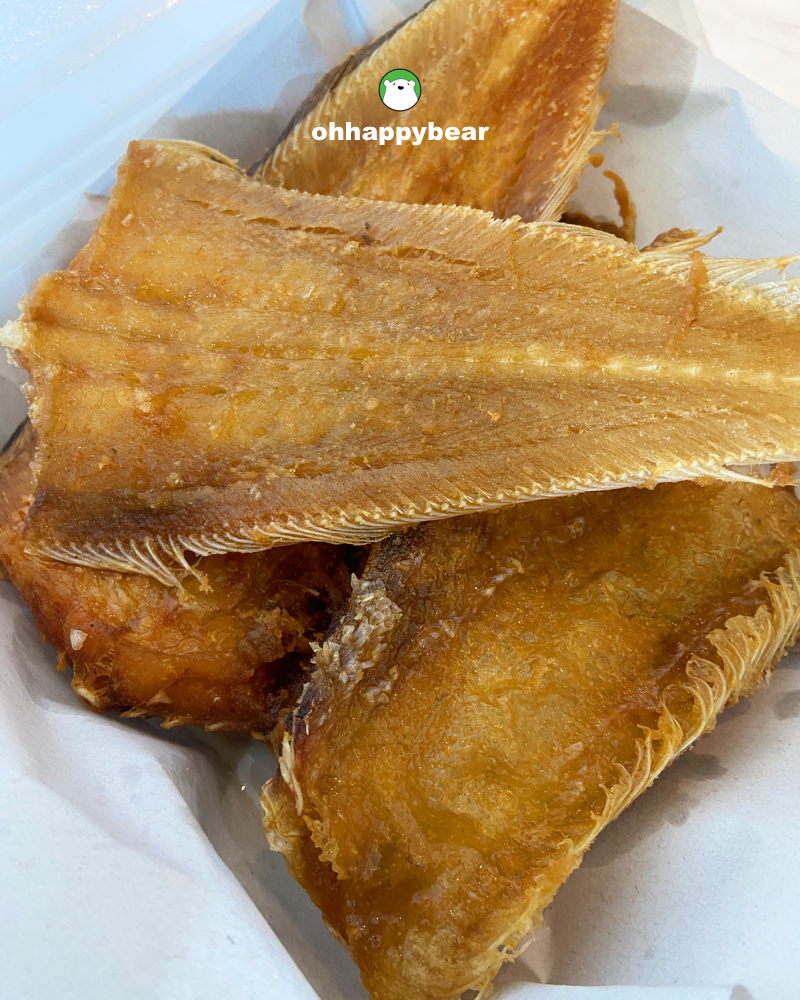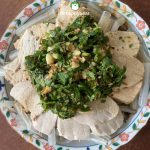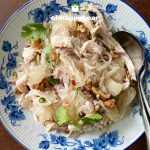Above: Pla Lin Ma (Soleidae) Tod Nam Pla (deep-fried sole with sweetened fish sauce) in Pranburi. The fish that used to be discarded or sold for the sake of good riddance is now becoming popular in Pranburi.
My earlier memories of Hua Hin always involved trays of freshly steamed blue swimming crabs – the type of local crab known in Thai as ‘Pu Ma.’ I remembered going at it with abandon, both ends of my elbows dripping with the crab juices, my two hands busy handling the treat. The Thai spicy seafood sauce, as I am recalling back, must be ample and nearby. We usually have the steamed crabs, along with other seafood items, with steamed rice. Baked fish? We can use our spoon and fork. BBQ squid, no problem with the utensil. Tom Yum soup? Spoon for sure. So, typically for me, the crabs are meant to be eaten last. This is because once you started at it, you couldn’t stop until it’s all over. The hands would be too messy to even grasp the spoon, not to mention the glass of water in case the throat got dry. That’s how it went. That’s how it’s still going for me. 😀 (Below is the mentioned Pu Ma, the delicacy of Thailand’s local crabs thanks to their more delicate and sweeter flesh).
Of course, those days were long gone now. Things had become more scarce everywhere, and we are seeing fresh Pu Ma crabs and the crabmeats becoming more and more exorbitant in prices. Pu Ma has apparently been our favourite to the point that we almost depleted the entire natural harvesting system. Local fishermen, at the forefront of the battlefields, grouped up with an effort to sustain the supplies by NOT harvesting pregnant crabs, but instead separate them and keep them in a safe place called ‘Crab Bank‘ (ธนาคารปู) until they spawned and their babies large enough to be released back into the sea.
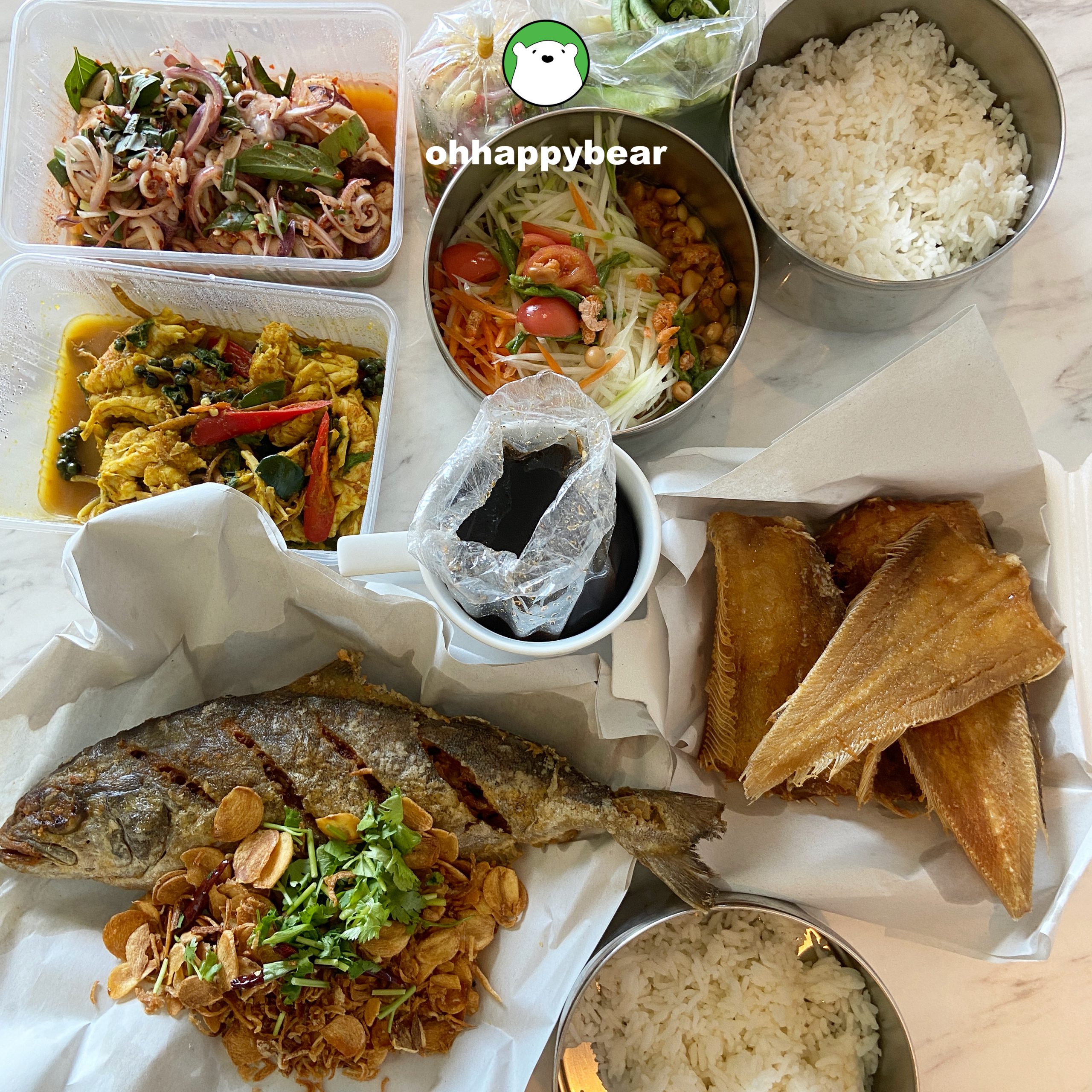 Above: A meal of ours in Hua Hin (shuttled from Pranburi) with Pla Lin Ma Tod Nam Pla as the neutral zone amidst fiery dishes. Tiffin boxes our own. 😀
Above: A meal of ours in Hua Hin (shuttled from Pranburi) with Pla Lin Ma Tod Nam Pla as the neutral zone amidst fiery dishes. Tiffin boxes our own. 😀
Not too long ago, we took a mini-vacation to Hua Hin just to get out of the rut. With the covid cases getting slightly better in Bangkok, we decided to go to Hua Hin, which only took about 3 hours from where we live. Our plan was simple: we only needed a change of scenery. And to minimize human contact, foods will be ordered in. We would stay as much as we could in the hotel room. We’d do anything to keep ourselves safe. Turned out, however, that throngs of people (who I assumed were also from Bangkok) were echoing our thoughts. On the beach, as far as we could see from the front of our resort, was packed! I mean, PACKED! This was the first time that we were at the beach, but never really got the chance to hit the beach. Our feet never touched the sacred ground.
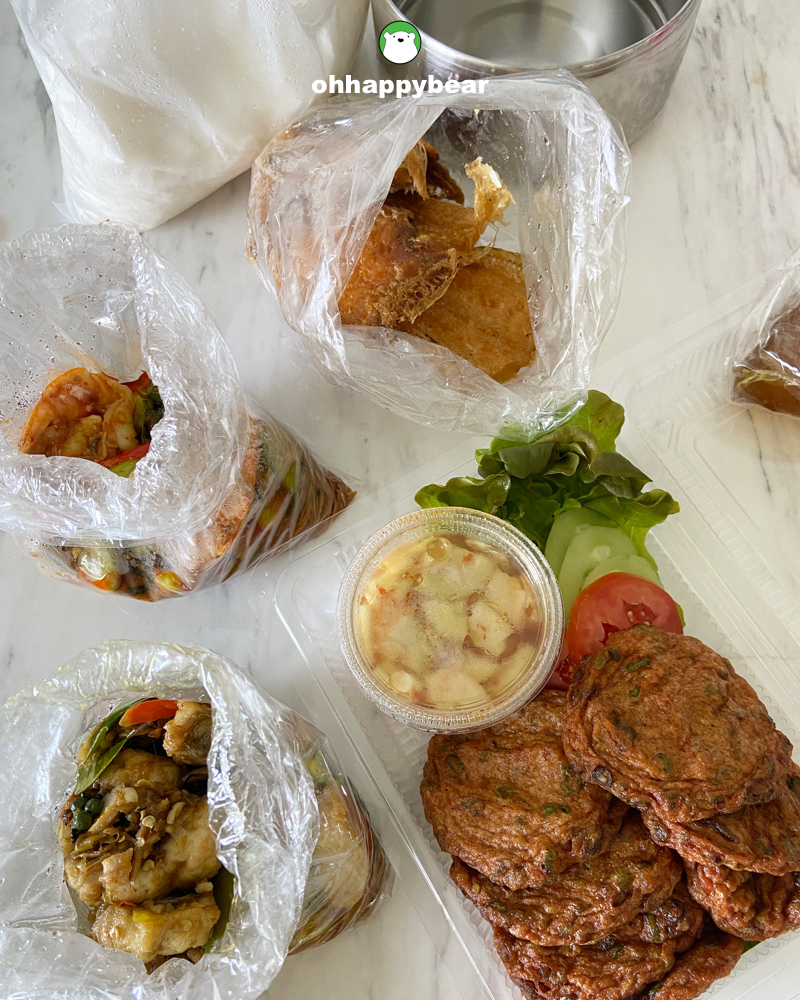 Above: Another meal of ours in Hua Hin. Pla Lin Ma Tod Nam Pla apparently has become our favourite. The flesh so cottony and delicate. Delicious beyond words.
Above: Another meal of ours in Hua Hin. Pla Lin Ma Tod Nam Pla apparently has become our favourite. The flesh so cottony and delicate. Delicious beyond words.
Foodwise, though, things were just fantastic. But while staying at the luxury of Hua Hin’s comfort, we ventured down to Pranburi for deliciousness. Pranburi is about 25 kilometres south of Hua Hin. And with the all-new scenic highway, we made it there and back within an hour. We ordered from our favourite places, picked up, came back to the room and ate.
And the whole eating thing in Pranburi made me think. We can really measure the trends of our foods throughout the different periods of our time. Blue swimming crabs have gone from being a family beachside staple to something that could reflect the financial status of the eaters. A 500g tin of crabmeat, depending on the size, can shave you off a whopping THB2,000. Ordering a tray, say 8 crabs, steamed, it will be about THB1,200. Not baby crabs, but not giant.Just something in between.
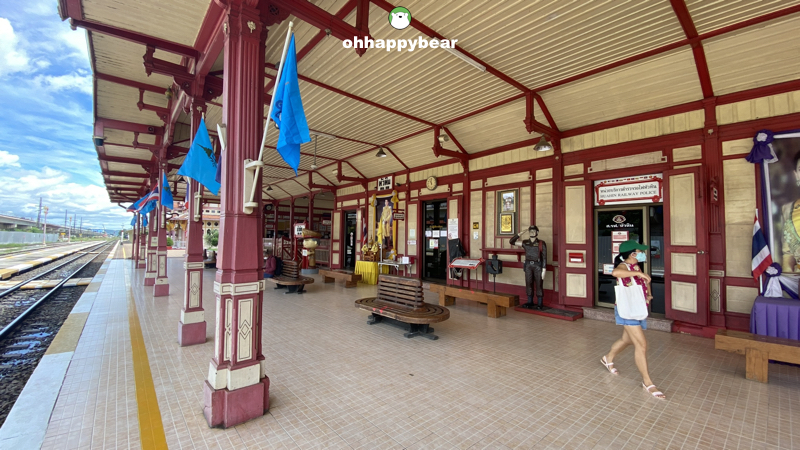 Above: Me browsing through Hua Hin’s Rail Station, circa 1926, now an award-winning preserved building by the ASA (The Association of Siamese Architects). The first train ran from Bangkok Noi in Thonburi to Hua Hin station on 25 November 1911, covering the distance of 213 kilometres.
Above: Me browsing through Hua Hin’s Rail Station, circa 1926, now an award-winning preserved building by the ASA (The Association of Siamese Architects). The first train ran from Bangkok Noi in Thonburi to Hua Hin station on 25 November 1911, covering the distance of 213 kilometres.
Fish has a similar story. I grew up eating so many kinds of fish than I can count. Mom went to the market, came back with whatever she thought was fresh with a great deal (4 siblings, values came first). I used to eat Pla Lin Ma, the sole, the strange-looking flatfish with a double eye, at home. Thought nothing about it, until, yes this particular trip to Pranburi.
In Thailand, like anywhere in the world, we have gone from fresh, wild-caught fishes to series of aquaculture. Farmed snappers, for the sake of prices and sustainability, are still prominent, especially in Bangkok and large-scale restaurants throughout the country. We have also seen the ups and downs of farmed white shrimps, especially the bad press that declared the business unsafe for our mangrove-lined coastlines. We imported farmed fishes from overseas, chilled and frozen. We marveled about the low prices of farmed salmon until we knew that not everything cheap is good. And here we are: knowing too much, enjoying too little. The more you know, the more suffering you’d be. For that, I can guarantee you.
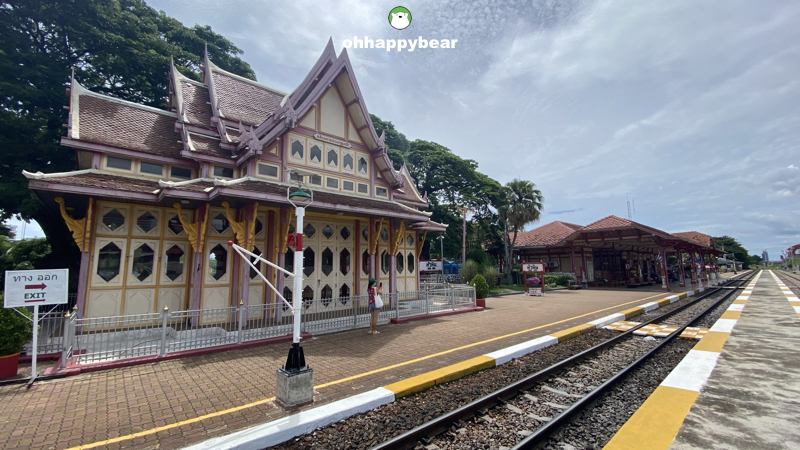 Above: A part of the main rail station is this exquisite pavilion used during the era of King Rama VI.
Above: A part of the main rail station is this exquisite pavilion used during the era of King Rama VI.
But Pla Lin Ma – an epitome of a cheapskate, the fish that were caught up inadvertently, is now becoming a hot item off the menus of many local restaurants in Pranburi. Featured, ordered, and raved! And pictured and proliferated via IG, too. Even though in French cuisine, a sole meunière is deemed a big-ticket item, much appreciated by Julia Child, Pla Lin Ma – which is the local sole – never had such limelight.
“It was the fish that was so so cheap, the fish that was about to be thrown away by fishermen who then sold them at cost for anyone knowing how to cook them,” Earth, a chef, and a local Praburi-nian, told me over the phone. Earth and I met at the Blue Lotus Vegan Cooking Class years ago, and now re-connected via IG where I learnt that Earth is also pondering to venture out on his own in a vegan food business.
“Pla Lin Ma was never actually or intentionally caught for trade. They are usually brought up along with other fishes, hence selling for nothing. But now, as you can see, things have changed, a lot of them are on the menu. And since more people are now eating it, they are getting more expensive, but still not to the point that fancier restaurants would buy them and feature them to their upscale clients.”
Pla Lin Ma that I am talking about here is called ‘Soleidae’ – a type of seawater fish abundant in the seas along the Gulf of Thailand. In Pranburi, if you want to try Pla Lin Ma, make sure you go to a local seafood restaurant, and not the one catering to tourists or fancier clients. The one cooking method that has proven to be always delicious is Pla Lin Ma Tod Nam Pla – crispy fried and ladled over with sweetened fish sauce. This is a simple dish but it tastes so good. Apparently, we are now in the phrase of food fashion that about-to-be-thrown-away fishes are becoming a mainstream. The prices of Pla Lin Ma, thanks to it being widely eaten now, have also become more expensive as well. Still, I bought the fish, fried and all, at THB150 per order. An order contains two fishes.
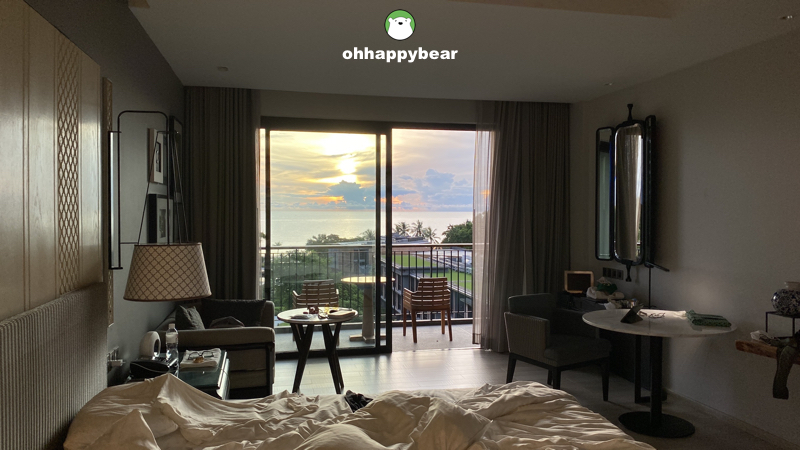 Above: Hua Hin is the place for sunrise (facing east), so early birders might love it. A view from our room. Cloudy days throughout our recent stay. But still we had a wonderful time.
Above: Hua Hin is the place for sunrise (facing east), so early birders might love it. A view from our room. Cloudy days throughout our recent stay. But still we had a wonderful time.
To tell you the truth, a sole is a sole. And even though our sole had never been so dramatically appraised, the fish is simply delicious. Delicate and cottony. The tiny crispy bones on the sides of the fish are the best part. Crunchy, slightly oily. They are delicious on their own and act like a neutral zone between the fires of other spicy things we usually eat in a seafood meal. It was an excellent – and still affordable – treat!
A LITTLE NOTE FROM US: If you are enjoying reading this blog, as we hope you all are, please kindly consider making a donation to charity causes listed HERE as a way to give us support. Your acts of kindness are always appreciated. Many thanks.
A LITTLE NOTE FROM US: If you are enjoying reading this blog, as we hope you are, please kindly consider making a donation to charity causes listed HERE as a way to give us support. Your acts of kindness are always appreciated. Many thanks.
